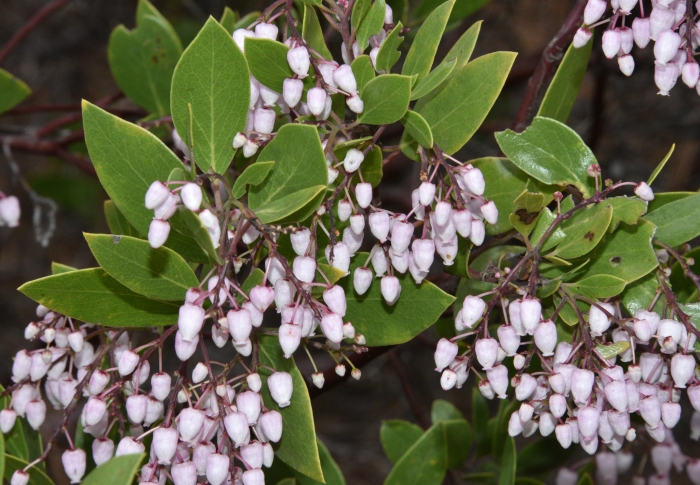Stanford’s Manzanita
(Arctostaphylos stanfordiana)
Stanford’s Manzanita (Arctostaphylos stanfordiana)
/
/

Don Loarie
CC BY 4.0
Image By:
Don Loarie
Recorded By:
Copyright:
CC BY 4.0
Copyright Notice:
Photo by: Don Loarie | License Type: CC BY 4.0 | License URL: http://creativecommons.org/licenses/by/4.0/ | Rights Holder: Don Loarie | Publisher: iNaturalist | Date Created: 2019-04-11T08:26:36-07:00 |

























Estimated Native Range
Summary
Arctostaphylos stanfordiana, commonly known as Stanford’s Manzanita, is an evergreen shrub native to the chaparral and woodlands of the outer North Coast Ranges in northern California. It typically grows between 2 to 10 feet in height and has a spreading form. The leaves are oblong to lance-shaped, shiny green, and can be up to 2 inches long. From late winter to early spring, Stanford’s Manzanita produces loose clusters of pink to white urn-shaped flowers that are attractive to pollinators. Following flowering, it bears oblong drupes that are a food source for local wildlife.
Stanford’s Manzanita is valued for its drought tolerance and its ability to thrive in poor, rocky soils, making it a suitable choice for xeriscaping and native plant gardens. It is often used in restoration projects within its native range due to its ecological importance. In cultivation, it requires well-drained soils, minimal water once established, and full sun to part shade. While it is generally low-maintenance, it can be susceptible to fungal diseases in humid or overly wet conditions.CC BY-SA 4.0
Stanford’s Manzanita is valued for its drought tolerance and its ability to thrive in poor, rocky soils, making it a suitable choice for xeriscaping and native plant gardens. It is often used in restoration projects within its native range due to its ecological importance. In cultivation, it requires well-drained soils, minimal water once established, and full sun to part shade. While it is generally low-maintenance, it can be susceptible to fungal diseases in humid or overly wet conditions.CC BY-SA 4.0
Plant Description
- Plant Type: Shrub
- Height: 3-4 feet
- Width: 4-6 feet
- Growth Rate: Moderate
- Flower Color: Pink, White
- Flowering Season: Spring, Winter
- Leaf Retention: Evergreen
Growth Requirements
- Sun: Full Sun, Part Shade
- Water: Low, Medium
- Drainage: Fast, Medium, Slow
Common Uses
Bird Garden, Drought Tolerant, Groundcover, Low Maintenance, Showy Flowers
Natural Habitat
Native to the chaparral and woodlands of the outer North Coast Ranges in northern California
Other Names
Common Names: Stanford Manzanita
Scientific Names: , Arctostaphylos stanfordiana,
GBIF Accepted Name: